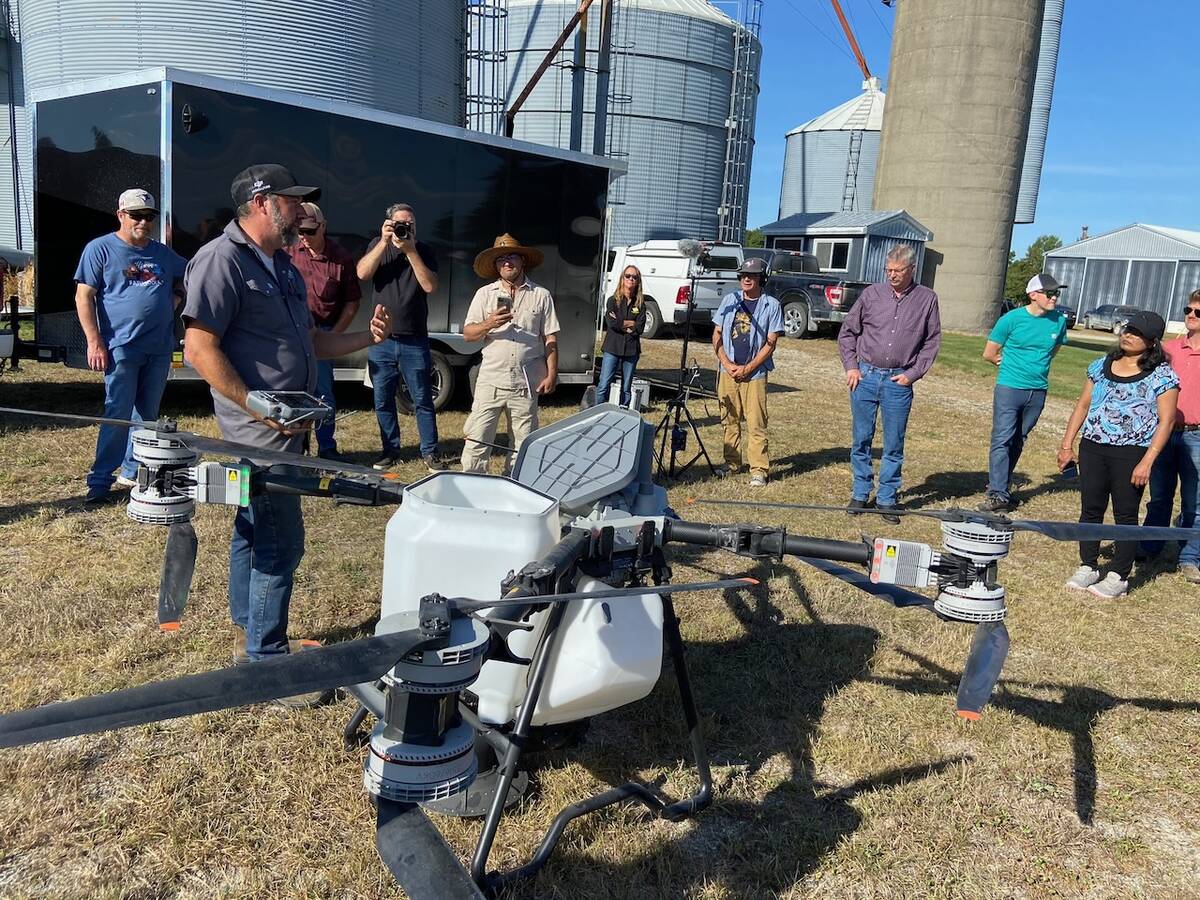Weekly provincial summary
Precipitation was variable across agro–Manitoba from June 5 to 11 with values ranging from 0 to 82.7 mm (see Table 1 at top). Isolated storms brought significant rainfall to areas in the Northwest regions on June 7 and 8, especially near San Clara and Rivers. San Clara (82.7 mm) received the most precipitation in the past seven days.
On June 7 and 8, a storm also passed through regions of the southwest. The Rivers station recorded a maximum wind speed of 101 km/hr at 18:54 pm. Recorded precipitation at the Rivers station during the storm was 32.45 mm, between 18:45 and 20:00 pm. Total Precipitation for Rivers was 41.84 mm on June 7 (some rain was received early in the morning) and 22.82 mm on June 8.
Read Also

Drones jumpstart cover crop planting
Drones are a tool that can help farmers with cover crop planting in still-growing corn and soybeans.
Climate normals for total accumulated precipitation from May 1 to June 11 range from 54.6 mm to 98.4 mm, and are based on 30-year historical data. Western areas of the province near San Clara, Deloraine, Waskada, and Rivers have received more than 120 per cent of normal precipitation since May 1. Much of the Central and Interlake regions are below 60 per cent compared to the 30-year average.
Soil moisture 0 – 30 cm shows a regional representation of soil moisture conditions for the top 30 cm on June 11, 2023 relative to field capacity. Soil moisture levels are variable throughout agro-Manitoba with the majority of the province showing optimal to wet conditions to the 30 cm depth. Some areas of the Central, Interlake, and Northwest regions are showing dry conditions.
Percent Normal Accumulated Growing Degree Days (May 1 – June 11) represents the variation of accumulated Growing Degree Days (GDD) from the historical record over a 30-year period. Continued warm temperatures has resulted in all of the agricultural regions in the province accumulating more than 125 per cent of normal GDD.
Provincial seeding progress is at 100 per cent complete except in regions where reseeding may occur due to recent storms.
To find interactive soil temperature/moisture and air temperature information see Agri-Maps Current Weather viewer.
Overview
Seeding is complete in Manitoba except in regions where reseeding may occur due to recent storms. Crops in the southwest region are being assessed due to a recent storm that moved through the region last week. Damage to the crops is still uncertain as cereals are looking reasonable, but other crops like canola, soybean, and sunflower appear to be severely affected. Damage is still being assessed. Spring cereal fields range anywhere from two leaf to very early flag stage. Crops have shown rapid development and remain in good condition. Soybean emergence has been variable in some regions due to seed sitting in dry soil; however, most soybean stands are quite acceptable. Growers continued to monitor fields for flea beetles in canola but in some regions the crop is advanced to the point where flea beetles are no longer a concern.
Cereals
Corn growth stages range from the V1 to V6 for the earliest seeded fields.
Spring cereal fields range anywhere from two leaf to very early flag stage. Crops have shown rapid
development and remain in good condition except for some later seeded fields demonstrating uneven
emergence due to topsoil dryness.
Fall rye heads are fully emerged and flowering over the last week. Winter wheat crops range from heads
half emerged to heads fully emerged and flowering. Winter cereals remain in good to excellent condition.
Oilseeds
Canola ranges from cotyledon to rosette stage with evidence of the start of bolt on the earliest seeded fields. Growers continue to monitor fields for flea beetles with only a few fields receiving an insecticide application. Some early seeded canola has now outgrown the flea beetle threat and monitoring of flea beetle feeding damage is being targeted to later seeded fields.
Sunflower growth ranges from the V2 to V6 stage with the crop demonstrating rapid growth and good to excellent condition.
Most flax crops are at growth stage 5 (stem extension) and the crop is expected to advance rapidly given the growing conditions.
Pulses and soybeans
Good emergence is noted on most pea fields around the province with the most advanced fields in the six to eight node stage.
Soybean growth stage ranges from first to second trifoliate stage with the last of post emergent rolling occurring this past week. Reports of uneven emergence due to soybeans sitting in dry soil.
Dry beans are emerging but have struggled in areas where soil moisture was lacking and seed is sitting in dry soil. Overall, emergence across the province is acceptable. There are a few reports of producers spraying for cutworms.
Forages and livestock
Forages
Spotty rains across the region have led to variable moisture conditions on pasture and hay-land. Most dairy producers have completed first-cut.
A handful of beef producers have also begun haying this week as alfalfa is in full bloom and grasses are mature. More beef producers are expected to begin cutting later this week.
The presence of alfalfa weevil has been noted on some fields in the Central region.
Reports on initial hay yields are highly variable and dependent on moisture conditions.
Forages continue to advance with grasses heading out and alfalfa beginning to bloom. Cutting of hay
fields has begun around Swan River.
Pastures would benefit from rain. Last week’s thundershowers were localized with some areas not
receiving any rain and, therefore, experiencing drier conditions.
Hay and pasture growth has slowed and is showing signs of moisture stress. Hay yields will be variable
and down from last year.
Livestock
Dugouts are approximately 50 per cent full in the Eastern region and some producers have noted that flies are more problematic than usual this year.
Producers are concerned that some paddocks and pastures will run short of water later in the season.
Cows are grazing with their calves in pastures.
Water supplies are good in the Southwest region.
Dugouts are 80-90 per cent full in the Southwest region.
Regional comments
Southwest
There were thundershowers and rain in most of the region last week. Temperatures were variable with hotter days and comparatively cooler nights. Heavy rainfall mixed with hail fell in the areas south of the Trans-Canada highway this past week. Melita, Pierson, and the Lauder/Dand area received 17-25 mm. Deloraine and Pierson saw up to 50-60 mm or more with some localized flooding.
Northwest areas of Trans-Canada highway received 20-25 mm of rain, but some pocket areas like Miniota, Rivers, Oak River, and Shoal Lake received 50-60 mm. Moisture conditions are adequate in most of the region but some areas like Eden, Birtle, Souris, and Alexander are still at below normal rainfall. An intensive storm on Wednesday night was roughly 5-8 km wide. It started northwest of Oak River and travelled at an angle towards Rivers.
Damage to the crops is still uncertain as cereals are looking reasonable but other crops like canola, soybean, and sunflower appear to be severely affected. Damage is still be assessed. There is potential for some reseeding to occur.
Seeding is complete in the Southwest with just a few acres left to be seeded for green feed. Spring cereals are advancing well with most at tillering stage. There are some reports of yellowing in barley due to dry weather conditions.
Peas are at the six to eight node stage and spraying is complete. Sunflowers are at V2 to V4 stage. There are some reports of cutworms in sunflowers but no significant damage. Corn is at the V4-V5 leaf stage and will benefit from recent moisture and heat. Soybeans are in the unifoliate to the first trifoliate stage with some fields having the first pass of herbicide applied. Canola is emerging well with the early seeded crop at the five to six leaf stage. Some areas are reporting flea beetle activity.
Fall rye has headed out, and winter wheat is just heading. Both crops look to be suffering some nitrogen deficiency due to poor environmental conditions impacting fertilizer management.
Last week, hot weather limited effective spraying periods to the mornings and evenings only. Spraying is approximately 50 per cent complete for in crop applications of herbicide.
Northwest
A week of high temperatures and high humidity moved crops along rapidly. Overnight temperatures were warm most of the week and then cooled off over the weekend. Highest precipitation amount was in San Clara, which received 83 mm. Excessive precipitation from the previous week caused challenges for in-crop herbicide and insecticide applications. Areas that were holding excess water in the field are showing signs of moisture stress.
Field pea emergence looks good and uniform and continuing nicely in the vegetative stages. Field peas are in the six to eight node stage. Spring cereal fields ranged anywhere from two leaf to six leaf stage. Winter wheat and fall rye are headed out and look to be in good condition. Soybeans are at the first trifoliate stage.
Earliest seeded canola is at the rosette stage, while the remainder of the canola crop continues to lag behind. There have been a few canola crops reseeded for various reasons – flea beetles, germination issues, hail/washouts have all contributed. Some canola fields have been able to outgrow flea beetle pressure – although insecticides have been required. Flea beetle feeding continues and requires monitoring. First pass herbicide is underway.
Central
Producers in the central region continued to see warm, dry and windy conditions. Many crops, especially corn and cereals, can be observed experiencing stress from lack of moisture. Patchy thunderstorms developed over the past week bringing some needed moisture; however, the rain was not widespread across the region. In general, the region would greatly benefit from rain.
Seeding is complete except for the occasional reseeding. Overall emergence on crops has been good, providing there was moisture at seeding depth, but those with dry soils have had much poorer emergence. Some soybean and canola in the driest fields remain stranded in the soil. The earliest seeded crops have had the most successful and uniform emergence due to the dryer soils at later planting. Most cereals are at the five to six leaf stage and tillering, canola around the five leaf stage, and soybeans range from emerging to the third trifoliate.
Most corn is between V3 and V6, with many fields having areas visibly showing moisture stress and associated nutrient deficiency symptoms, especially phosphorus purpling. Dry bean staging ranges from emergence to the first trifoliate. Winter wheat and fall rye are heading out with some fields beginning to flower. Sunflowers range from V2 to V6.
Grasshoppers have emerged and their populations are building, with some damage observed at the edges of fields near ditches, especially for cereals and dry beans. Some farmers are spraying for their control. Flea beetles and cutworms have been visible for many farmers, but only for a minority have they exceeded the threshold for pesticide application.
Eastern
The Eastern region experienced unseasonably hot and humid weather over the reporting period. Thunderstorms and the potential for violent weather continued to be a concern, particularly from Tuesday to Thursday of last week. Rainfall accumulations ranged from as little as 10 mm to over 40 mm with wide variations across the region. Total rainfall amounts for the week were higher in northern districts than central and southern districts. In all areas you can find dry zones with seed stranded at seeding depth as well as wet zones, where field access was limited due to temporary flooding. Isolated reports of hail damage were received but as crops were at earlier growth stages when damaged, they are generally recovering from injury.
Uneven germination resulting in thin stands and variable crop staging in some fields remains a top producer concern. Significant progress with spraying was made but producers were limited by windy conditions on some days. High daytime temperatures have delayed product application depending on the crop and chemistry involved. About 50 per cent of acres across the region have now received a first pass of herbicide. Cropland soil moisture remained mostly good across the region but it was noted that at least 10 per cent of cropland has moved into either the short or excess soil moisture categories. Producers look to continue making rapid progress on spraying in the coming week, but would still appreciate a widespread soaking rain or even more showers across the region to remedy crop emergence problems.
Fall rye heads have fully emerged and were flowering over the last week. Winter wheat crops range from heads half emerged to heads fully emerged and flowering. Winter cereals remain in good to excellent condition.
Spring cereal fields range anywhere from two leaf to very early flag stage. A few very late seeded fields were still emerging. Crops have shown rapid development and remain in good condition except for some later seeded fields demonstrating uneven emergence due to topsoil dryness.
Corn growth stage ranges from the V1 to V6 for the earliest seeded fields. Across the region, first pass herbicide applications are about 65 per cent complete and evaluations of the necessity for a second pass are ongoing. The crop remains in good to excellent condition and has demonstrated rapid growth in the warm weather.
Sunflower growth ranges from the V2 to V6 stage with the crop demonstrating rapid growth and good to excellent condition. First pass herbicide applications are mostly complete and evaluations of the need for a second pass are ongoing.
Canola ranges from cotyledon to rosette stage with evidence of the start of bolt on the earliest seeded fields. Producers continue to monitor fields for flea beetles with only a few fields receiving an insecticide application. Some early seeded crop has now outgrown the flea beetle threat and monitoring of flea beetle feeding damage is being targeted at later seeded fields. In lower rainfall areas, growers remain concerned about canola emergence, particularly for later seeded crop, fields where significant pre-seeding tillage had been done, and where seed had been broadcast and incorporated. Overall crop condition ranges from fair to good with only about 5 to 10 per cent of acres receiving a first pass of herbicide.
Most flax crops are at growth stage 5 (stem extension) and the crop is expected to advance rapidly given the growing conditions. Herbicide applications are still ongoing but close to complete. Some producers found it necessary to apply grass and broadleaf herbicides separately to optimize weed control and/or minimize crop injury, all of which has taken more time. The crop remains in good condition but timing of herbicide applications has been challenging.
Soybean growth stage ranges from emerging/cotyledon to the third trifoliate leaf stage for the earliest seeded crop. Crop growth and development was rapid in the warm weather. Field yellowing on the earliest seeded/most advanced crop continues with more acres yellowing each day. A few fields have started to green up again. With later seeded fields, producers remain concerned about topsoil moisture availability at seeding depth, particularly in those areas with lower overall rainfall accumulations. Overall, first pass herbicide application in soybeans is about 60 per cent complete but there is a lot of variability in progress from farm to farm.
The field pea crop ranges from the sixth to the eighth node growth stages. Herbicide applications are complete. The crop remains in good to excellent condition but growers in drier areas remain concerned about adequate soil moisture supply for the crop going forward.
Interlake
Scattered showers and thundershowers continue, with much variability in rainfall amounts across the Interlake region. Some areas in the south, such as Stonewall and Warren are dry. The east and north part of the Interlake region missed last week’s rainfall and soil conditions are very dry. However, Fisher Branch and Vidir received a good amount of rainfall this past week, about 25 to 50 mm. Heat stress on crops has been reported by producers. Although the majority of annual crop acres are still rated as adequate for topsoil moisture. Frequent rains will be needed to sustain crop growth through the season.
Seeding progress is 100 per cent complete for most crops, with the last fields being seeded to mostly annual crops for green feed. Reseeding continues as crop stands are evaluated following extreme heat stress. Uneven emergence, generally canola, in the Arborg and Riverton area is also impacted by dry conditions, injury from wind, and high temperatures, along with significant flea beetle damage. Almost all crops have stagey emergence but need more rainfall to keep going.
Wheat mostly ranges from the three to four leaf stage with earlier fields reporting five to six leaf. Most soybeans are in the cotyledon to unifoliate stage, with first trifoliate starting to show. Early second trifoliate are starting to show in the most advanced fields in the south. Sunflowers are mostly V2 to V4 leaf, with patchy emergence; some plants are still coming through.
Flea beetles continue to be a concern in canola ,with high pressure reported in some areas, and are being closely monitored. Producers in the Teulon area reported a drop in flea beetle pressure. There have been reports of a heavy number of grasshoppers along the edges of some fields north of Petersfield and Winnipeg. Insecticide has been applied in some fields, particularly with multiple stresses.
Weed pressure is high in many areas in the north Interlake, whereas the south Interlake area reported lighter than normal weed pressure. Herbicide spraying is well underway and is about 50 to 60% complete in wheat and soybeans.















